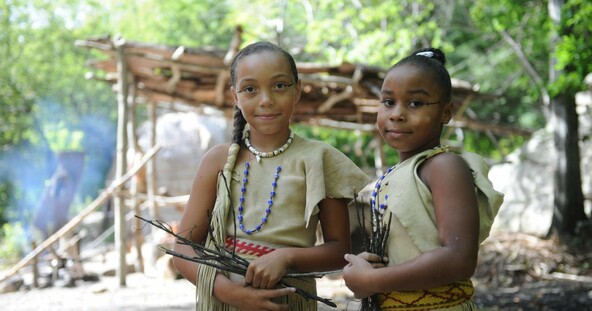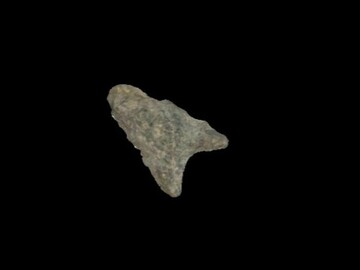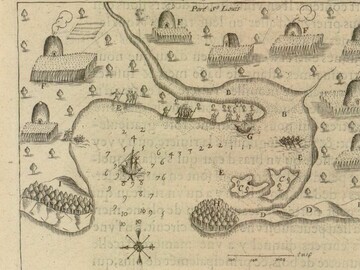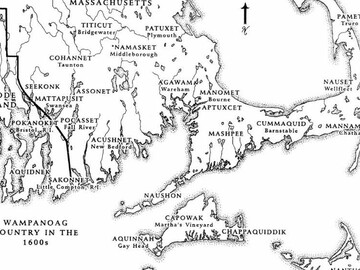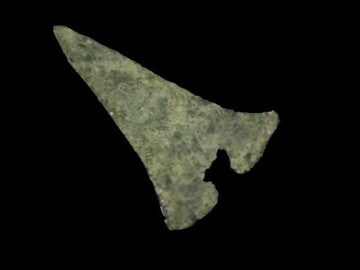Unit 1: Summary
This Unit aligns with the Patuxet Stratigraphy Sort" (Activity 1) in the “You are the Historian” Interactive Game.
Learning Themes:In this unit, students use archaeological material, maps, and excerpts from written sources to explore how Wampanoag culture transformed between the end of the last Ice Age 11,500 years ago and the arrival of Mayflower in 1620. Materials explore how Wampanoag people adapted to changing climates and ecosystems and built political, economic, and kinship networks of independent communities across the region before and after Europeans first inserted themselves into those networks. Upon completion, students should understand that Wampanoag people have (and continue to live) in their homelands for thousands of years, but not in stasis.
Key Ideas
- The North Atlantic was a bridge that connected Europeans and Indigenous Americans for more than a century before 1620.
-
Wampanoag and other Indigenous people still live on or near the fields, forests, and waterways their ancestors settled thousands of years ago
-
The Pilgrims were not the first Europeans that Native people encountered. By the early 16th century, European fisherman and adventurers began trading along New England’s shores.
-
The arrival of Europeans introduced new materials, trade items, languages, and ways of looking at the world which transformed Wampanoag life and culture in the 1600s.
-
After many generations, Wampanoag culture continues to adapt to new circumstances and develop new tools and ways of living. It is still growing and adapting today.
- Archaeologists study the past by looking at the things - or artifacts - people made and left behind in the ground. They use stratigraphy (the study of rock and soil layers) and context to interpret artifacts. Knowing where archaeological artifacts were found helps us understand how and when they were used.
Learning Goals
In this unit, students will:
-
Describe how people in the past lived and research their values and beliefs
- Demonstrate how holding different values and beliefs can contribute or pose obstacles to understanding between people and groups
- Describe interactions between and among individuals, groups, and institutions
-
Identify and describe examples of tensions between and among individuals, groups, and institutions
-
Identify examples of science and technology in daily life
-
Give examples of conflict and cooperation among individuals, groups, and nations in different parts of the world
-
Identify and examine how wants and needs of people in one part of the world may conflict with the wants and needs of people in other parts of the world
- Locate, access, organize, and apply information from multiple sources reflecting multiple points of view
Essential Questions
- What is archaeology? How do archaeologists understand the past?
-
How did cultural exchange between Indigenous communities impact how people lived in Patuxet?
-
How did Wampanoag culture transform between the end of the last ice age to the arrival of European explorers?
-
How did European explorers describe the Northeast and Indigenous Peoples?
-
How did encounters with European fishermen, explorers and colonists change daily life at Patuxet?
-
How did the interactions between Wampanoag and other Indigenous and European communities shape the development of Plymouth Colony? Massachusetts? The United States?
-
Why is the diversity of Indigenous cultures unfamiliar to some Americans?
Suggested Activities
Grades K-5
- Make a timeline of Wampanoag history by putting the artifacts and sources from Unit 1 in chronological order. How did Wampanoag lifeways and culture changed from the end of the ice ages (approximately 11,500 years ago) to the earliest arrival of Europeans in southeastern New England in 1524?
- Choose 2-3 artifacts from this data set and ask students to do research to learn more about how these artifacts were used every day by Wampanoag people. Challenge students to make a new map of Patuxet featuring their artifacts.
- Find Patuxet/Plymouth, Massachusetts on a modern map. How has the landscape changed compared to the early 1600s? What has stayed the same?
- Analyze Champlain’s map of Patuxet/Port Saint Louis (1605) alongside The Wampanoag Way (best for grades 1-4) or Paddling Through History (grades 5+) and this essay for young readers about building homes. What did Champlain accurately portray? What might not be accurate on his map?
- Ask the students to make a map of their school or classroom including key landmarks they think would be important for new students. Have students explain what landmarks they chose to include and why that information is important.
Grades 6-12
- Create a short essay, graphic novel, or illustrated story to reconstruct what daily life was like for a Wampanoag family using 5-7 artifacts from the unit.
- Choose 4-5 artifacts from this data set and ask students to do research to learn more about how these artifacts were used every day by Wampanoag people. Find examples of them being used in Champlain’s map or his written description of Patuxet. How are these artifacts being used? Based on what you learned, what did Champlain get right? What did he get wrong? Challenge students to annotate the map or the written description to include more information about Wampanoag people in the 1600s.
- Curate an exhibit explaining how the arrival of Europeans starting in the early 1500s impacted Indigenous communities in the northeast and connect it to what happened in your own community’s history. Don’t forget to consider economics, leadership, physical geography, and daily life.
- Explore how Wampanoag culture transformed in response to climate changes such as global warming after the end of the ice ages. What are some examples of how our communities are adapting and transforming in response to climate changes today?
- Compare the descriptions of Patuxet written by Champlain (1613) and the authors of Mourt’s Relation (1622). How did Patuxet change? What caused those changes?
Additional resources
- The Wampanoag Way
- Echoes of the Ancestors - Transformations of Wampanoag Life from the Paleoindian Period through the Colonial Era
- History in a New Light: Illuminating the Archaeology of Plymouth at Patuxet.
- Ben Franklin’s World: The World of the Wampanoag, Part I (Before 1620) featuring Darius Coombs from the Mashpee-Wampanoag Nation; Lorén Spears, Executive Director of the Tomaquag Museum and citizen of the Niantic-Narragansett nation; Dr. Jade Luiz (Associate Professor of Anthropology, Metropolitan State University of Denver); and Dr. Drew Lipman (Associate Professor of History, Barnard College)
- Ben Franklin’s World: The World of the Wampanoag, Part II (1620 and Beyond) featuring Darius Coombs from the Mashpee-Wampanoag Nation; Carla Pestana, author of The World of Plymouth Plantation; Dr. Jade Luiz (Metropolitan State University of Denver); and Dr. Drew Lipman (Associate Professor of History, Barnard College)
- Learn about storytelling as a primary source
Curriculum Alignments
K.T2
How do maps, globes, and photographs show different things about a place?
K.T4
What kinds of work do women, men, and children do?
1.T2
How can maps help people locate places and learn about them?"
2.T1
What do maps show?
2.T2
How do people adapt to or change their environment?
2.T3
What are the different reasons people choose to settle in a community?
3.T2
How did Native Peoples live in New England before Europeans arrived?
3.T3
How did European explorers describe the Northeast and its Native Peoples?
4.T2
How do archaeologists develop theories about ancient migrations?
4.T4
How has the environment shaped the development of each region?
5.T1
To what extent was North America a land of opportunity, and for whom?
6.T2
How did life on Earth begin and why did humans form complex societies?
WHI.T1
What kinds of global connections existed among humans in the past?
WHI.T3
How did the interactions of kingdoms and empires [c.1000-1500] influence political, economic, and social developments?
Econ.T7
Why are the costs and benefits of trade agreements among nations?
Economic Decision Making
- D2.Eco.1.3-5., D2.Eco.2.3-5.
- D2.Eco.1.6-8., D2.Eco.1.9-12., D2.Eco.2.9-12
Exchange and Markets
- D2.Eco.4.K-2., D2.Eco.6.K-2., D2.Eco.3.3-5.
The Global Economy
- D2.Eco.14.K-2., D2.Eco.15.K-2., D2.Eco.14.3-5., D2.Eco.15.3-5.
- D2.Eco.14.6-8., D2.Eco.15.6-8.
Spatial Views of the World
- D2.Geo.1.K-2. D2.Geo.2.K-2., D2.Geo.3.K-2., D2.Geo.1.3-5., D2.Geo.2.3-5., D2.Geo.3.3-5.
- D2.Geo.1.6-8., D2.Geo.2.6-8., D2.Geo.2.9-12.
Place, Regions, and Culture
- D2.Geo.5.K-2., D2.Geo.6.K-2., D2.Geo.4.3-5., D2.Geo.5.3-5.,D2.Geo.6.3-5
- D2.Geo.4.6-8., D2.Geo.4.9-12., D2.Geo.5.6-8., D2.Geo.5.9-12., D2.Geo.6.6-8., D2.Geo.6.9-12.
Spatial Patterns and Movements
- D2.Geo.7.K-2., D2.Geo.8.K-2., D2.Geo.9.K-2., D2.Geo.7.3-5., D2.Geo.8.3-5.
- D2.Geo.9.6-8
Change, Continuity, and Context
- D2.His.1.K-2., D2.His.2.K-2., D2.His.3.K-2., D2.His.1.3-5., D2.His.2.3-5., D2.His.3.3-5.
- D2.His.1.6-8., D2.His.2.6-8., D2.His.3.6-8., D2.His.1.9-12., D2.His.2.9-12., D2.His.3.9-12.
Perspectives
- D2.His.4.K-2., D2.His.6.K-2., D2.His.4.3-5., D2.His.5.3-5., D2.His.6.3-5.
- D2.His.4.6-8., D2.His.5.6-8., D2.His.4.9-12., D2.His.5.9-12., D2.His.6.9-12., D2.His.7.9-12., D2.His.8.9-12.
Historical Sources and Evidence
- D2.His.9.K-2., D2.His.10.K-2., D2.His.12.K-2., D2.His.9.3-5., D2.His.10.3-5., D2.His.12.3-5., D2.His.13.3-5.
- D2.His.10.6-8., D2.His.12.6-8., D2.His.13.6-8., D2.His.12.9-12.
Changing Spatial Patterns
D2.Geo.10.6-8., D2.Geo.11.6-8., D2.Geo.12.6-8., D2.Geo.11.9-12.
Causation and Argumentation
- D2.His.14.6-8., D2.His.15.6-8., D2.His.16.6-8., D2.His.14.9-12., D2.His.15.9-12., D2.His.16.9-12.
CCSS.ELA-LITERACY.RH.6-8.1
Cite specific textual evidence to support analysis of primary and secondary sources.
CCSS.ELA-LITERACY.RH.6-8.3
Identify key steps in a text's description of a process related to history/social studies (e.g., how a bill becomes law, how interest rates are raised or lowered).
CCSS.ELA-LITERACY.RH.6-8.4
Determine the meaning of words and phrases as they are used in a text, including vocabulary specific to domains related to history/social studies.
CCSS.ELA-LITERACY.RH.6-8.5
Describe how a text presents information (e.g., sequentially, comparatively, causally)
CCSS.ELA-LITERACY.RH.6-8.6
Identify aspects of a text that reveal an author's point of view or purpose (e.g., loaded language, inclusion or avoidance of particular facts).
CCSS.ELA-LITERACY.RH.6-8.7
Integrate visual information (e.g., in charts, graphs, photographs, videos, or maps) with other information in print and digital texts.
CCSS.ELA-LITERACY.RH.6-8.9
Analyze the relationship between a primary and secondary source on the same topic.
CCSS.ELA-LITERACY.RH.9-10.3
Analyze in detail a series of events described in a text; determine whether earlier events caused later ones or simply preceded them.
CCSS.ELA-LITERACY.RH.9-10.4
Determine the meaning of words and phrases as they are used in a text, including vocabulary describing political, social, or economic aspects of history/social science.
CCSS.ELA-LITERACY.RH.9-10.6
Compare the point of view of two or more authors for how they treat the same or similar topics, including which details they include and emphasize in their respective accounts.
CCSS.ELA-LITERACY.RH.9-10.7
Integrate quantitative or technical analysis (e.g., charts, research data) with qualitative analysis in print or digital text.
CCSS.ELA-LITERACY.RH.9-10.9
Compare and contrast treatments of the same topic in several primary and secondary sources.
CCSS.ELA-LITERACY.RH.11-12.2
Determine the central ideas or information of a primary or secondary source; provide an accurate summary that makes clear the relationships among the key details and ideas.
CCSS.ELA-LITERACY.RH.11-12.3
Evaluate various explanations for actions or events and determine which explanation best accords with textual evidence, acknowledging where the text leaves matters uncertain.
CCSS.ELA-LITERACY.RH.11-12.6
Evaluate authors' differing points of view on the same historical event or issue by assessing the authors' claims, reasoning, and evidence.
CCSS.ELA-LITERACY.RH.11-12.7
Integrate and evaluate multiple sources of information presented in diverse formats and media (e.g., visually, quantitatively, as well as in words) in order to address a question or solve a problem.
CCSS.ELA-LITERACY.RH.11-12.9
Integrate information from diverse sources, both primary and secondary, into a coherent understanding of an idea or event, noting discrepancies among sources.
CCSS.ELA-LITERACY.RL.6.1
Cite textual evidence to support analysis of what the text says explicitly as well as inferences drawn from the text.
CCSS.ELA-LITERACY.RL.6.2
Determine a theme or central idea of a text and how it is conveyed through particular details; provide a summary of the text distinct from personal opinions or judgments.
CCSS.ELA-LITERACY.RI.6.4
Determine the meaning of words and phrases as they are used in a text, including figurative, connotative, and technical meanings.
CCSS.ELA-LITERACY.RI.6.5
Analyze how a particular sentence, paragraph, chapter, or section fits into the overall structure of a text and contributes to the development of the ideas.
CCSS.ELA-LITERACY.RI.6.7
Integrate information presented in different media or formats (e.g., visually, quantitatively) as well as in words to develop a coherent understanding of a topic or issue.
CCSS.ELA-LITERACY.RI.7.3
Analyze the interactions between individuals, events, and ideas in a text (e.g., how ideas influence individuals or events, or how individuals influence ideas or events).
CCSS.ELA-LITERACY.RI.7.4
Determine the meaning of words and phrases as they are used in a text, including figurative, connotative, and technical meanings; analyze the impact of a specific word choice on meaning and tone.
CCSS.ELA-LITERACY.RI.7.9
Analyze how two or more authors writing about the same topic shape their presentations of key information by emphasizing different evidence or advancing different interpretations of facts
CCSS.ELA-LITERACY.SL.7.2
Analyze the main ideas and supporting details presented in diverse media and formats (e.g., visually, quantitatively, orally) and explain how the ideas clarify a topic, text, or issue under study
CCSS.ELA-LITERACY.RI.8.3
Analyze how a text makes connections among and distinctions between individuals, ideas, or events (e.g., through comparisons, analogies, or categories).
CCSS.ELA-LITERACY.RI.8.6
Determine an author's point of view or purpose in a text and analyze how the author acknowledges and responds to conflicting evidence or viewpoints.
CCSS.ELA-LITERACY.RI.8.9
Analyze a case in which two or more texts provide conflicting information on the same topic and identify where the texts disagree on matters of fact or interpretation.
CCSS.ELA-LITERACY.RI.9-10.3
Analyze how the author unfolds an analysis or series of ideas or events, including the order in which the points are made, how they are introduced and developed, and the connections that are drawn between them.
CCSS.ELA-LITERACY.RI.9-10.6
Determine an author's point of view or purpose in a text and analyze how an author uses rhetoric to advance that point of view or purpose.
CCSS.ELA-LITERACY.RI.9-10.7
Analyze various accounts of a subject told in different mediums (e.g., a person's life story in both print and multimedia), determining which details are emphasized in each account.
CCSS.ELA-LITERACY.RI.9-10.9
Analyze seminal U.S. documents of historical and literary significance (e.g., Washington's Farewell Address, the Gettysburg Address, Roosevelt's Four Freedoms speech, King's "Letter from Birmingham Jail"), including how they address related themes and concepts.
CCSS.ELA-LITERACY.RI.11-12.3
Analyze a complex set of ideas or sequence of events and explain how specific individuals, ideas, or events interact and develop over the course of the text.
CCSS.ELA-LITERACY.RI.11-12.7
Integrate and evaluate multiple sources of information presented in different media or formats (e.g., visually, quantitatively) as well as in words in order to address a question or solve a problem.
CCSS.ELA-LITERACY.RI.11-12.9
Analyze seventeenth-, eighteenth-, and nineteenth-century foundational U.S. documents of historical and literary significance (including The Declaration of Independence, the Preamble to the Constitution, the Bill of Rights, and Lincoln's Second Inaugural Address) for their themes, purposes, and rhetorical features.
CCSS.ELA-LITERACY.L.8.4.C
Consult general and specialized reference materials (e.g., dictionaries, glossaries, thesauruses), both print and digital, to find the pronunciation of a word or determine or clarify its precise meaning or its part of speech.
CCSS.ELA-LITERACY.L.8.6
Acquire and use accurately grade-appropriate general academic and domain-specific words and phrases; gather vocabulary knowledge when considering a word or phrase important to comprehension or expression.
CCSS.ELA-LITERACY.L.9-10.6
Acquire and use accurately general academic and domain-specific words and phrases, sufficient for reading, writing, speaking, and listening at the college and career readiness level; demonstrate independence in gathering vocabulary knowledge when considering a word or phrase important to comprehension or expression.
CCSS.ELA-LITERACY.L.11-12.6
Acquire and use accurately general academic and domain-specific words and phrases, sufficient for reading, writing, speaking, and listening at the college and career readiness level; demonstrate independence in gathering vocabulary knowledge when considering a word or phrase important to comprehension or expression.
